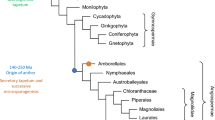Summary
The forest annual, Amphicarpaea bracteata L. can reproduce via aerial chasmogamous, aerial cleistogamous, and subterranean cleistogamous flowers. Both plant size and light intensity influenced the utilization of the three modes of reproduction. chasmogamous and aerial cleistogamous flower number and the ratio of chasmogamous flowers to the total number of aerial flowers increased with plant size. The latter demonstrated a shift to xenogamy and outbreeding in larger plants. Light intensity indirectly influenced reproductive modes through its infuence on plant size. Seed set by both types of aerial flowers was low and unrelated to plant size. Subterranean seed number and the total dry weight of subterranean seeds per plant increased with size. The subterranean seeds of Amphicarpaea bracteata are thirty-four times larger than the aerial seeds (fresh weight). Under field conditions, subterranean seeds had greater germination after one year than acrial seeds. The plants arising from subterranean seeds were significantly larger and more fecund than those from aerial seeds. Seeds produced by aerial cleistogamous, hand selfpollinated chasmogamous, and naturally pollinated chasmogamous flowers had equivalent germination rates and produced plants of equal size and fecundity. This suggests that the outbred progeny from chasmogamous flowers have no advantage over the inbred progeny from aerial cleistogamous flowers.
Similar content being viewed by others
References
Allard HA (1932) Flowering behavior of the hog peanut in response to length of day. J Agric Res 44:127–137
Cheplick GP, Quinn JA (1982) Amphicarpum purshii and the ‘pessimistic strategy’ in amphicarpic annuals with subterranean fruits. Oecologia (Berlin) 52:327–332
Hurlbert SH (1984) Pseudoreplication and the design of ecological field experiments. Ecol Monogr 54:187–211
Levins R (1968) Evolution in changing environments. Princeton University Press, Princeton
Lloyd DG (1984) Variation strategies of plants in heterogenous environments. Biol J Linn Soc 21:357–385
Lord EM (1981) Cleistogamy: a tool for the study of floral morphogenesis function and evolution. Bot Rev 47:421–449
Myers JL (1979) Fundamentals of experimental design. Allyn & Bacon Inc., Boston
Neter J, Wasserman W, Kunter MH (1983) Applied linear regression models. RD Irwin Inc., Homewood, Illinois
Pilj L van der (1982) Principles of dispersal in higher plants. Springer, Berlin Heidelberg New York
SAS Institute Inc. (1985) SAS User's Guide: Statistics, Cary, North Carolina
Schemske DW (1978) Evolution of reproductive characteristics in Impatiens (Balsaminaceae): the significance of cleistogamy and chasmogamy. Ecology 59:596–613
Schively AC (1897) Contributions to the life history of Amphicarpaea monoica Contrib Bot Lab Penna Univ 1:270–363
Schnee BK, Waller DM (1986) Reproductive behavior of Amphicarpaea bracteata (Leguminosae), an amphicarpic annual. Am J Bot 73:376–386
Schoen DJ, Lloyd DG (1984) The selection of cleistogamy and heteromorphic diaspores. Biol J Linn Soc 23:303–372
Sokal RR, Rohlf FJ (1981) Biometry. WH Freeman & Co, San Francisco
Trapp, EJ (1986) Mixed reproductive tactics in the hog peanut, Amphicarpaea bracteata L. PhD thesis, Univ of Iowa, Iowa City
Turner BL, Fearing OS (1964) A taxonomic study of the genus Amphicarpaea (Leguminosae). Southwest Nat 9:207–218
Uphof JCT (1938) Cleistogamic flowers. Bot Rev 4:21–49
United States Environmental Data Service, Climatological Data (Iowa) Annual Survey (1983–1984) Vol 94–95, National Oceanic and Atmospheric Administration, National Climate Center, Asheville, North Carolina
Venable DL (1985) The evolution of seed heteromorphism. Am Nat 126:577–595
Waller DM (1980) Environmental deteminants of outcrossing in Impatiens capensis (Balsaminaceae). Evolution 34:747–761
Wilken DH (1982) The balance between chasmogamy and cleistogamy in Collomia grandiflora (Polemoniaceae). Am J Bot 69:1326–1333
Author information
Authors and Affiliations
Rights and permissions
About this article
Cite this article
Joseph Trapp, E., Hendrix, S.D. Consequences of a mixed reproductive system in the hog peanut, Amphicarpaea bracteata, (Fabaceae). Oecologia 75, 285–290 (1988). https://doi.org/10.1007/BF00378611
Received:
Issue Date:
DOI: https://doi.org/10.1007/BF00378611




